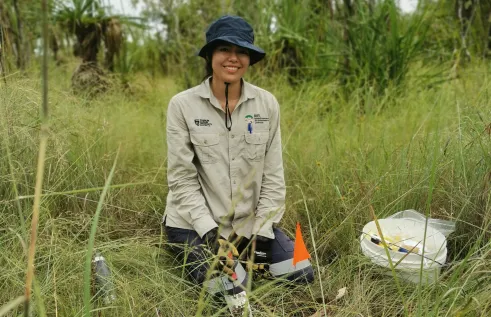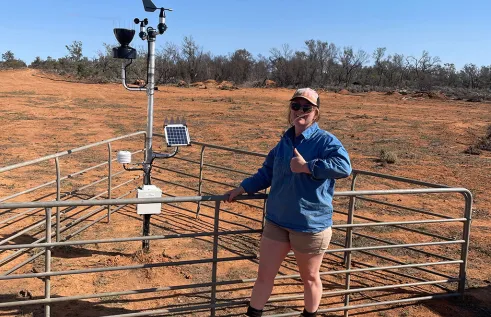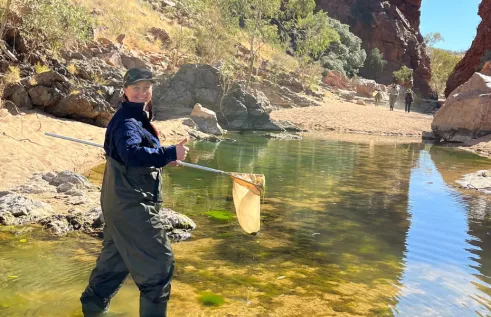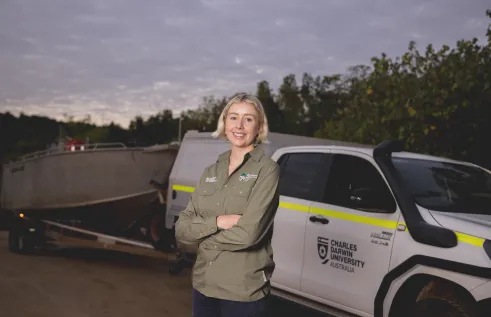Research impact
Little critters, big impact

Mining is one of Australia’s largest industries. The environmental impact it has can be very high on local ecosystems, while rehabilitation efforts are costly and difficult to truly measure. PhD candidate Allyson Malpartida is trying to change that.
She is doing this with the help of ants and termites as indicators of rehabilitation. The method, called metabarcoding of DNA samples, captures each species’ genetic signature at former Northern Territory mine sites to analyse the health of the ecosystem.
Allyson, who is studying a Higher Degree by Research with the College of Engineering, IT & Environment, compares ant and termite communities of disturbed ecosystems undergoing rehabilitation with relatively intact ecosystems to measure the ecosystem health.
Healthy terrestrial invertebrates are important to a healthy ecosystem. Invertebrates like ants are very sensitive to changes in the environment, so they are good indicators of ecosystem health.
Allyson found that many researchers avoid invertebrate sampling due to the complexity, requiring a specialist for identification of the large number of potential species. To combat this issue, she is using environmental DNA (eDNA) in addition to typical identification methods.
“For eDNA we are getting our DNA samples from places like the soil, or even a termite bait, which has trace DNA left behind by the insects that move through or onto those substrates.”
Eyes on the future
By using sample collections at Ranger Uranium Mine in Kakadu National Park, Allyson hopes to help develop long-term monitoring to be incorporated into the national park.
“The data from DNA sequences can be stored and reanalysed years later. When more species are added to reference databases the analysis can be rerun and more can be picked up over time, which is great for regulatory monitoring.”
The signs of invertebrates returning means some larger animals have a food source and can return to a disturbed site too. We need invertebrates to be back before everything else comes back to the land.
Northern Territory-led data
Using data collected from her samplings at Ranger Uranium Mine, Nabarlek Uranium Mine, Pine Creek Gold Mine and Jabiluka Mine, Allyson's goal is to develop a cost-effective and reliable technique for assessing the restoration efforts of mine sites.
“My goal is to develop a method for monitoring terrestrial invertebrate bioindicators long-term and make it more available for different companies and organisations to use the technology to assess land restoration,” she said.
CDU and the College of Engineering, IT & Environment are actively seeking Higher Degree by Research students to take part in projects just like these. Scholarships are available. Learn more.
Related Articles

Following the flock: Samantha’s research could revolutionise water point placement
When Samantha first moved to South Australia's harsh outback, she was confronted by what she saw.
"Having recently moved to arid pastoral South Australia, I was struck by the hot, dry climatic conditions," she says. "I found myself questioning what made these landscapes so resilient, how livestock production could thrive in such conditions and whether this relationship was truly sustainable."
Read more about Following the flock: Samantha’s research could revolutionise water point placement
The NT inspired Kate to become an environmental scientist
A road trip around Australia sparked a huge career change for Kate. The recent Bachelor of Environmental Science graduate switched gears from real estate to environmental science after falling in love with the uniqueness of the Northern Territory.
Read more about The NT inspired Kate to become an environmental scientist
Julia's unexpected road to species-saving research
Julia is researching sharks and rays here in the Top End at Charles Darwin University, a world away from her upbringing in north-western NSW. She's working to ensure some of Australia's most threatened species are around for many generations to come.
Read more about Julia's unexpected road to species-saving research